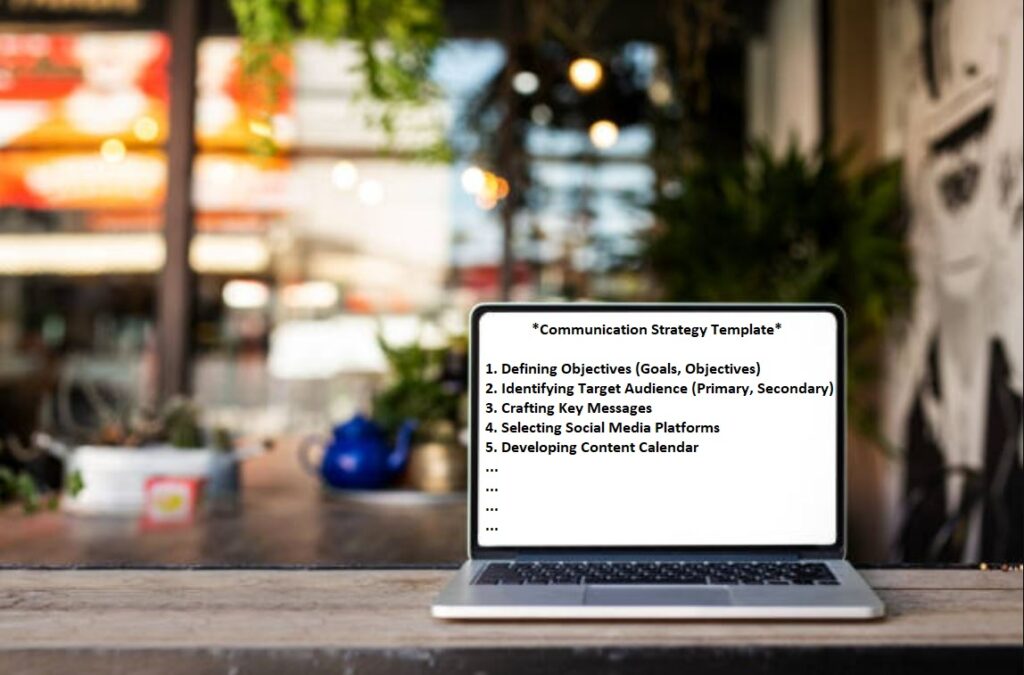In this article “How a good communication strategy can help a business to grow?” will write more about, what is a good communication strategy, why it is important for businesses and how this can help a business to grow?
A communication strategy is a plan that organizations e.g.: Greenfrastructures Creative Agency or individuals develop to convey information effectively to their target audience.
Communication strategy and goals
A communication strategy is a comprehensive approach that outlines
- how communication goals will be achieved,
- what messages will be conveyed
- through which channels, and
- with what frequency.
A well-developed communication strategy ensure that the right message reaches the right audience at the right time.
Marketing Communication Strategy
A marketing communication strategy is a plan outlining
- how a business or
- organization will convey its messages to its target audience to achieve specific marketing goals.
It involves deciding
- what to communicate,
- to whom,
- through which channels, and
- how to measure the effectiveness of these efforts.
The aim is to create a cohesive and impactful approach to engage and influence the target audience.
Key components of a communication strategy
Goals and Objectives
Clearly defined goals and measurable objectives that the communication efforts aim to achieve. These could be related to
- increasing awareness regarding a business,
- changing perceptions
- specific actions for example increasing conversions, etc.
Target Audience
Identifying and understanding the
- characteristics,
- needs, and
- preferences of the audience the communication is intended for.
Key Messages
Defining the main points or ideas that need to be communicated to convey the desired information or influence opinions.
Channels and Platforms
Determining the most effective channels and platforms for reaching the target audience.

This could include
- traditional media (such as newspapers, television, radio) or
- digital channels (websites, social media, email).
Timing and Frequency
Planning
- when and
- how often
communication activities will take place to maximize impact and engagement.
Stakeholder Engagement
Identifying and involving relevant stakeholders who can influence or be affected by the communication efforts.
Budget and Resources
Allocating resources, both financial and non-financial, necessary to implement the comm. strategy effectively.
Feedback and Evaluation
Establishing mechanisms to
- collect feedback and
- evaluate the success
of the communication strategy against the set objectives. This involve metrics like
- audience reach,
- engagement, and
- attitude change etc.
Communication Strategy Template
This template made by the Greenfrastructures Creative Agency and its use and reproduction are not allowed without explicit permission from the agency.
Communication Strategy: Marketing XYZ Firm on Social Media
Defining Objectives
- Goal: Increase brand visibility and client acquisition for XYZ Firm through social media marketing.
- Objectives:
- Increase the firm’s social media following by X% in the next Y months.
- Generate leads for new client consultations through social media channels.
- Enhance brand perception by showcasing expertise and reliability.
Identifing Target Audience
- Primary Audience:
- X and Y-sized business owners
- XYZ in need of tax planning and accounting services
- Secondary Audience:
- XYZ entrepreneurs
- XYZ2
Crafting Key Messages
- Main Points:
- Expertise: ….
- Personalized Service: ….
- Industry Compliance: ….
Selecting Social Media Platforms
- Primary Platforms:
- X
- Y
- Z
Developing Content Calendar
- Frequency:
- Posts
- Webinars, etc.
- Content Types:
- …
- …
- ….
Engagement and Interaction
- Community Building:
- Response
- UGC etc.
Collaborations and Partnerships
- Leverage Collabs:
- Ask prices here: [email protected]
Organic and Paid Advertising
Analytics and Evaluation
- Metrics:
- Tracking
- Monitoring performance
Adaptation and Optimization
- Feedback Loop

Made by Greenfrastructures Creative Agency
Internal Communication
Strategy
An effective internal communication strategy is pivotal for fostering a cohesive and productive workplace environment.
It involves
- the systematic planning and
- implementation of communication processes within an organization to ensure that information is disseminated efficiently and transparently.
This strategy encompasses various channels, for instance
- emails,
- intranet platforms,
- meetings, and
- internal messaging systems,
to facilitate the seamless flow of information.
A well-crafted internal communication strategy not only keeps employees informed about company goals, policies, and updates but also promotes a sense of belonging and shared purpose.
Regular communication from leadership, opportunities for feedback, and open channels for dialogue contribute to a culture of collaboration and employee engagement. This, in turn, enhances overall organizational performance and helps employees align their efforts with the company’s objectives.
Trends in 2024
AI is The Future
AI is shaping the future of workplaces,
- automating tasks,
- personalizing experiences, and
- improving decision-making.
Clear strategies and usage policies are very important for protecting sensitive data. While AI enhances communication and content creation, balancing it with human-generated content is essential for authenticity. PwC reports that 68% of organizations plan to use AI-driven tools for employee experience and frontline worker support.
Hyper-Personalized Internal Communication
Hyper-personalization is transforming internal communication trends, leveraging data and automation to send personalized messages based on employees’ roles, interests, and locations. AI plays a key role in achieving unprecedented levels of personalization.
According to a Deloitte survey, 85% of organizations planned to invest more in personalization and targeted messaging for frontline workers in 2023. Tailoring communications to specific factors ensures timely delivery of critical information, acknowledges workforce diversity, and provides opportunities for employee recognition.
Targeted communication important with advanced audience segmentation and content segmentation, which ensures precise delivery of information at the right time based on multiple criteria.
Visual communication and video is on the rise
Visual communication just like reels in everywhere is on the rise, with video gaining preference over text for enhanced engagement and faster information processing. (A survey from Reddit shows that in the beginning of 2024 reels became the most importatn communication factor in social media.)
Asynchronous Video Conferencing is saving effort in communication, and short-form and vertical videos are vital in communication strategies. Video’s engaging nature, combining visuals, audio, and storytelling, improves message retention. It simplifies complex information, conveys emotions effectively, and enhances employee engagement, making it a powerful tool for internal communication.
Mobile first communication
Mobile devices, particularly for frontline workers, are crucial in the evolving landscape of internal communication trends. Effective communication with frontline staff is vital,
- providing clear information,
- promoting engagement, and
- contributing to a positive workplace culture.
This engagement builds trust, boosts morale, and ultimately impacts customer satisfaction and organizational success. Apps which keeps frontline workers connected to company news, enhancing talent retention and overall operational efficiency.
Human-Centered Internal Communication
Prioritizing Human-Centered Communication is crucial in today’s tech-driven workplace. Authentic leadership and empathy are gaining importance as technology automates tasks.
Mental health is a key focus, with employees expecting
- authenticity,
- improved communication, and
- empowerment.
Human-centered internal communication is essential for
- building a positive and inclusive company culture,
- impacting employee satisfaction and organizational success.
Apps which supports this approach with features like internal communication surveys, feedback channels, and CSR modules, contributing to employee well-being and engagement.
Sustainable Communication Strategy
A sustainable communication strategy, when designed for longevity and consistency, is a holistic approach that incorporates enduring principles of environmental and social responsibility into the core messaging of a business.
This strategy goes beyond short-term campaigns, aiming to embed sustainability into the organizational culture and operations. By consistently highlighting eco-friendly practices, ethical sourcing, and community engagement, businesses can build a lasting narrative that resonates with consumers and stakeholders.
This sustained communication reinforces the company’s commitment to responsible business practices, fostering trust and credibility over time.
Furthermore, it enables businesses to adapt to evolving societal expectations, ensuring that their communication remains relevant and resonant throughout the years.
In essence, a sustainable communication strategy important for start-ups and businesses on the short- and long-run. It needs to prioritizes enduring sustainable core values to become an integral part of a company’s identity, and contribute to long-term success and positive societal impact.
